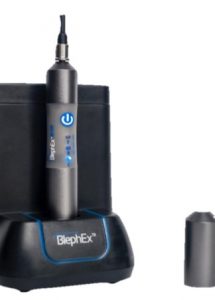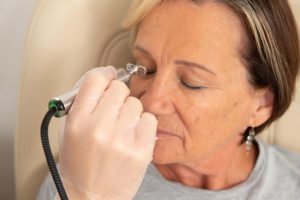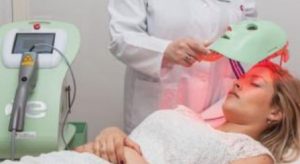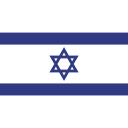Once your doctor has determined which type of Dry Eye you have and what is the cause of your dry eye, there will be several treatment options available. Part of the treatments will be applied in the clinic and the complementary part of your Dry Eye Symptoms management will take place at home by changing some of your lifestyle.
Treatment at the Dry Eye Center
Blephlex
 You may not have noticed but your eyelids were never thoroughly washed! This is probably the only part of your body that wasn’t. Because of the accumulation of debris on your eyelids, and the natural physiology of glands discharges, a plaque is created on the margin of your eyelids. Very much like the well-known teeth plaque which is treated in the dental hygienist clinic, your eyelids biofilm should be cleaned regularly.
You may not have noticed but your eyelids were never thoroughly washed! This is probably the only part of your body that wasn’t. Because of the accumulation of debris on your eyelids, and the natural physiology of glands discharges, a plaque is created on the margin of your eyelids. Very much like the well-known teeth plaque which is treated in the dental hygienist clinic, your eyelids biofilm should be cleaned regularly.
When untreated, this plaque allows the multiplication of unhealthy bacteria, which secrete toxins and cause Blepharitis that may lead to Meibomian Gland Dysfunction. In order to restore a healthy eyelid a technology called Blephex has been developed to clean the virulent biofilm. The cleaning is performed at the clinic in a relaxed position and is not painful at all. Specifically designed and precise micro-sponge is applied over your eyelashes and removes the plaque, the dirt and the unhealthy biofilm. The micro-sponge is replaced with each new patient. The procedure lasts 6-8 minutes. Usually the treatment is being repeated every 4 to 6 months. In a recent study patients treated with Blephlex have shown 54% decreased in mean blepharitis and Meibomian Gland Dysfunction severity!
MiBoFlow
Since evaporative dry eye is the leading cause of dry eye, restoring Meibomian gland function can significantly improve most of the dry eye symptoms. Restoration of a healthy meibum is the mainstay of modern Meibomian Glands Dysfunction therapy.
significantly improve most of the dry eye symptoms. Restoration of a healthy meibum is the mainstay of modern Meibomian Glands Dysfunction therapy.
The meibum is produced by the Meibomian Glands liquefies at 43ºC, and pulsatile pressure on the Meibomian Glands has been shown to free the obstructed glands as well as restore their function. Based on these principles, a technology called Miboflow has been developed and is currently efficiently used in hundreds Dry Eye Center in the USA and other countries.
MiBoFlow generates a stable continuous radiant heat source. This heat is gently applied through a silver eye pad on the outer skin of the eyelids. Gentle therapeutic massage is applied to the lids during 8 to 16 minutes. The heat is absorbed by the inner lid surface and transmitted to the Meibomian Glands. This allows for gland evacuation and enhances tear function through liquefaction of inspissated meibomian gland secretions. Repeat MiBo treatments produce rejuvenation of Meibomian Glands function and treats excessive tear evaporation. By optimizing the tear film lipids, MiBo improves vision and comfort.
Is Miboflo dangerous? The risks are minimal since the thermal energy is tightly regulated, therapy duration is timed and the treatment is applied by certified professional. The lid skin is protected by a medical grade coupling agent and the anti-microbial properties. Corneal warpage, eyelid injury, skin damage, pain, foreign body sensation, excessive tearing, photophobia, and redness from MiBo have been neither described nor documented. Furthermore, MiBoFlow is in use many years in post-operative LASIK, and cataract surgery.
Recent studies show excellent post-therapy visual acuity, and an immediate sensation of comfort in the eyes. Like all Dry eye treatment the salutary effects of MiBo is not eternal and repeat treatment every 6 to 12 months may be necessary to obtain a complete remission of the MGD.
Lipiflow
It is also a thermal pulsation system. Unlike the Miboflow instead of an operator dependent massages, Lipiflow is applied to the Eyelids and the patient is left in a room for the machine to deliver a 12 minutes automated treatment.
IPL

Intense pulse light, is a well-known technology in dermatology for acne and rosacea for many years. More recently IPL is used in treatment of Dry Eye. IPL application on the eyelids is believed to provoke coagulation and blockage of the abnormal blood vessels that secretes inflammatory mediators in the area. In addition IPL decreases the bacteria activity in the Eyelids by the antiseptic effect of its UV light.
Life style
As you understand by now, Dry Eye Disease is chronic and multifactorial. A proper diagnosis and classification at your Dry Eye Center will allow your doctor to address you to the most appropriate treatment at the center. In order to make the most of the treatment and benefit of a long term amelioration of your symptoms you will be invited to make a few adaptation of your life style and or to continue maintenance treatment at home.
Avoidance of aggravating factors
Logically, if your eyes are especially dry in certain conditions we will recommend that you reduce them. For example:
- Stop smoking or wear glasses when you smoke until you can stop smoking.
- Undergo an optometrist examination so that you wear the appropriate glasses and don’t tire your eyes.
- When reading long hours, take a few pauses and do blinking exercise for 30 seconds.
- Use humidifiers while using heat and air conditioning.
- Avoid allergy triggers such as hay fever, pollen, dust, animals, etc.
- Reduce the use of medication causing dry eye like antidepressant or sleeping pill with the advice of your general practitioner.
- You tend to blink less frequently so the symptoms aggravated, use appropriate glasses, light and try to blink more.
- Minimize Contact lens wear.
Omega-3 fatty acids
Omega-3 fatty acids, ideally from both fish and flaxseed sources, are very healthy. Omega-3 fatty acids have a beneficial effect on dry eye due to their anti-inflammatory properties. They are also essential fatty acids that your eyelids and tear film need to function their best, be their healthiest and their most comfortable. Unfortunately, our body cannot produce them and most of us don’t get enough Omega-3s from our diet. Omega-3 fatty acids are an important part of any complete dry eye relief program; they also benefit the health of your joints and your heart.
Eyelid Hygiene
Each day when you are washing your face, either at the sink or in the shower, you should “shampoo” your eyelashes and clean your eyelids. You shouldn’t use your face or bar soap because they dissolve the healthy oils of your tears. There are shampoos for eyelids that your doctor will recommend.
Applying a warm compress to your closed eyelids for 5-10 min prior to cleaning your eyelids/eyelashes will liquefy your skin oils and loosen crust, thus enhancing your cleaning. Dr. Kaplan and her staff will teach you how to do this optimally, including massaging the oil secreting glands in your eyelids.
Use of Artificial Tears, Gels and Ophtahlmic Ointments
Artificial tears unlike Blephex, Miboflo or the change of your lifestyle will not treaty our dry eye, it will only improve your comfort. By applying water in various drops you will wet your eye, and feel improved. Of course improving the quality of your life is very important but it is also very important to prevent further damage of your ocular surface by using NON preserved artificial tears..
- Preservative Free Artificial Tears: These products vary in their consistency, some are the consistency of water, while others are thicker, or more viscous. You should begin by using these drops 4 to 6 times each day. These drops can be instilled in your eyes with your contact lenses in.
- Preservative Free Gels: These products are more viscous, or thicker than drops, and therefore stay on the ocular surface longer. The drawback is that they can blur vision, but only slightly and only temporarily (i.e. for one to two minutes). If you are able to tolerate these during daytime hours they are good for your comfort. You should use them a minimum of four times a day. If you cannot tolerate minimally blurry vision during daytime hours, you can use them at bedtime. Gels are also great to use while flying, as the air in airplanes is extremely dry.
Humidifiers
Using a humidifier when you’re traveling, on your desk at home or at work and at your bedside is of great benefit. This is especially true if you travel to dry environments, in the fall and the winter, and when the heat and air conditioning are on.
Hydration
Staying well hydrated is extremely important. Drinking 7 to 8 ounce glasses of water each day, or drinking enough water until your urine is straw colored, is ideal.
Sleep
Being well rested is imperative to your overall health and the health of your eyes. Getting 7 to 8 hours of sleep each night is recommended. Nighttime eye shields can protect your eyes while you sleep. These are especially helpful if you sleep with your eyes partially or intermittently open, or if you sleep with a ceiling fan, a regular fan, near a vent, or with a Cpap machine.
Treating other Eye Conditions
It is extremely important to diagnose and properly treat other eye conditions that can exacerbate dry eye and make it much more difficult to treat (i.e. allergies, blepharitis, meibomian gland dysfunction, rosacea, etc.).
Anti-inflammatory Treatments
Dry eye Syndrome is accompanied by an inflammation of the ocular surface.
This ongoing inflammation causes long term damage to the surface of your eyes and to your tear producing glands, therefore further reducing tear production over time if not properly treated. Your eye Specialist may or may not decide to treat this inflammation. Below is a non exhaustive list of medications in the form of drops or ointment or steroids, antibiotics, or more to treat the inflammation.
- Corticosteroids: Steroids can be used in the form of eye drops which are available in varying strengths. Throughout any treatment with steroids, Dr. Kaplan’s team will monitor your eyes closely to make certain you don’t have any side effects or complications.
- Topical Cyclosporine-A (Restasis): treats dry eye by suppressing inflammation, increasing tear production and by protecting your lacrimal glands (tear glands) from being continuously damaged over time.
- Xiidra (lifitegrast ophthalmic solution 5%): An FDA approved eye drop, taken twice daily, which improves both the signs and symptoms of dry eye.
- Tacrolimus drops or ointment: have been shown to improve tear stability and the health of the ocular surface. Tacrolimus is also beneficial in the treatment of allergies which affect the eyes.
- Tetracycline/Doxycycline: When prescribed in their full strength/dosages these medications function as antibiotics. When prescribed at lower dosages, this group of medications act as anti-inflammatory agents. Azasite (azithromycin ophthalmic solution) is an antibiotic eye drop that also has anti-inflammatory properties.


